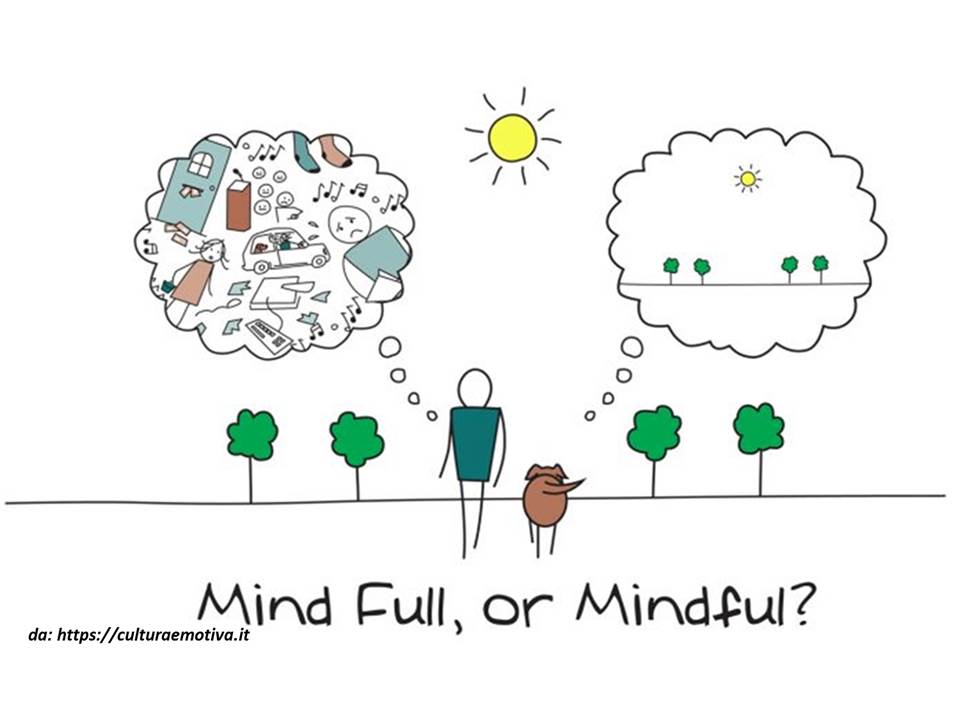NATURE COACHING / MINDFULNESS
Coaching and mindfulness – Introduction
Let’s now enter in a fascinating. although somewhat complex, terrain. Especially since we are talking about things with a prominent individual component: from both the side of the ones offering a or receiving coaching services. and that of receiving it. Where is therefore the secret ? Just in finding the meeting point between the client (coachee) and the coach, and in developing the activities in a coherent way.
Mindfulness is instead a condition to be attained, but also a precious tool. In the Italian text I stressed how English words are often used, and abused and that, what is important, is that they are not abused to hit imagination and deliver hidden fake information.
Nature coaching / mindfulness. piudimille.com
Coaching and mindfulness: what are they
Coaching
Should you like to read formal definitions of what is “coaching” see, as an example, the page on Wikipedia. You can also read the personal pages of many coaches, explaining the topic using personal style and from individual perspectives. Be cautious, however, to avoid losing yourself.
Those of you familiar with sport disciplines often hear the word coach as a synonym of trainer. From a certain point of view this is correct, but the analogy with sport holds only to a certain point.
Here, as usually, I also refer to personal approaches, that is what really matters on my activities, mainly addressed to individual persons.
Coaching is substantially a free agreement between two, or sometimes more than two, subjects.
One is the person asking for the coaching service, often called coachee: he / she is feeling the need of “doing something”, sometimes he also more or less knows what, but also feeling the lack of appropriate instruments to start. A very important point: the client asking for a coaching service is in full control of his mental resources, not needing therefore a psychological service.
The other subject is the coach, offering the service: he “trains” the coachee to find his way, without however, in most cases, giving any prescription. The relation between the two is, as said, completely free and can be interrupted at any moment.
Mindfulness
In my Italian text I noticed that the literal translation of “mindfulness” into Italian would render “awareness”. Awareness, however, contains an ethical background, a moral judgement about what could be better or worse; so is not this. Let’s intend instead “mindfulness” as “presence”, that is pretty correct. It means to be completely in only one place, with body and mind.
That’s great. Think well: this is the contrary of what we usually are used to do. We tend to identify the so-called multitasking as symptom of efficiency, modernity, capacity. Think about a simple and common example: all those people doing different things while listening to music with earphones. Mindfulness is exactly the opposite: so, doing different things, but only one at a time, with full presence; no easy, but, just because of this, very satisfactory.
Wikipedia also gives an overview of mindfulness definitions and formal protocols.
nature coaching / mindfulness. piudimille.com
Coaching
Look at the image, that you may find on line, in many variants. It represents what should be the scope of coaching, so disentangling a ball of wool. It is just like this, bit not only. Let’s say that, once the thread is loose, it must be used, to do something. Another popular image is getting out a labyrinth: once out, we must take a road. So, in synthesis: to simplify, set an objective and attain it.
Sometimes there may be variations: it is not for granted that disentangling knots is the best strategy; sometimes, it could be easier simply to cut them, or break some walls, to get out of a labyrinth.
Mindfulness
Also in this case, an image, with many variants. The concept is quite similar to that of coaching, indeed. It then evocates “meditation”, that is an instrument of mindfulness. So, meditation is not the goal, that is, instead, presence. Presence is to stay concentrated on only one things by time, whatever it is, for a time that we allow. When we do not succeed anymore, let’s skip to something else. Why all this ? Try, to believe: this approach can change our life, also substantially. See however how much far from reality can be our imaginary: “meditation” is often considered as an abstract, not very practical thing; on the contrary, it can be the key to attain a status of full concentration and application.

Effects of mindfulness: to semplify and consider on efeeling at a time, in the present place and moment
Coaching and mindfluness
And now a light could switch on. Do you think to be able to disentangle a complicate know without full concentration? Or to use a sharp blade thinking of something else ? or, could you get out of a labyrinth ? driving a car with continuous distractions, still hoping to take the correct road ? Or immediately realise when you missed your way ?
Well, these are some example of why presence is good for coaching, and vice versa.
Coaching and mindfulness: how to do
Coaching
As illustrated, coaching is a relation between two contractors: the coach, offering a service and the coachee, receiving it. In some cases, the coachee can also be a group, either formal or informal.
The first session, dealing with the coaching relationship and contract, is devoted to explain the method.
We already stated that the coaching program occurs in stage and that is van be finished in any moment. The coach, indeed, does not prescribe anything, does not sets objectives; he helps the coachee to clarify his goals and independently set objectives. It may also happens that the coachee is convinced to have an objective, to realise that it was instead a different maybe, also much simpler thing. And so, he may decide that he definitely does not need coaching anymore. On the other hand, the coach may realise that the coachee needs something different: in this case, he will openly tell to the coachee. This is the fun in coaching: the relationship is free, any can be ended in any moment.
It may also happen to start with an objective, to switch to a different one. Or that what initially looked as an objective then appears as a simple instrument. And much more.
On the thread is loosened, then the “training” phase follows. The objective must be however attainable, otherwise the risk is not to get through. But the coachee may need some “training”; the coach can therefore assign some homework and invite to verifications along the way.
All this occurs in different sessions, which number cannot be fixed is advance. Now we get acquainted to remote sessions, that may work well, and can also contribute to overcome some diffidence. However, in person sessions are far more potent.
You may often read some attributes, accompanying the word “coaching”. In my opinion, the substantial difference is between:
– coaching directly committed by individuals or, on the other hand, by organisations and firms
– in the first case, we can still distinguish between coaching addressed to professional or working problems, or to different aspects of the individual life, even if the difference is often not so clear-cut.
Life coaching or mental coaching are synonym expressions, generally referred to coaching applied to individual problems. This is the still less defined and, perhaps, more difficult category, at least because of the fact that the objective, either final or intermediate, are often not easily quantifiable with respect, as an example , to business or sport coaching.
This is however my may field of work (see also at the end: Nature coaching).
Mindfulness
Mindfulness or presence, is a status, that must be individually attained. However, present time lifestyles make perhaps most people being unaware of this. It maybe therefore useful a help, aimed at suggesting how to attain this status. Also in this case, it is a matter of a relationship between a facilitator and a client.
So, how to “do” mindfulness. Not entering in too much details, generally the starting point is to bring the attention to some functions of everyday life, such, at first place, but not only, respiration. To do this, some formal methodologies do exist, called in this way since they are based on tested protocols that therefore work well, especially to begin. Many of these procedures are based on physical or sensory processes, easier to handle, but other, a bit more difficult to afford, also refer to thoughts.
There are also informal approaches, applicable ponce a basic confidence has been acquired; their advantage is their intrinsic flexibility, since they can be adapted to the available moments and individual attitudes and can also become ways of life.
“Learning” mindfulness also requires periodic sessions, once again to be decided within a free relations between the facilitator and the client. Mindfulness as well requires a constant training, to be maintained. It is rather evident the affinity with coaching, that we see here below.
Coaching and mindfulness
So, independently on its type, a coaching relation requires: a) to clear off possible initial confusion; b) to set a final or intermediate objectives; c) to organise actions to attain the objective. It is rather clear how the “presence” is fundamental.
In this perspective, mindfulness becomes therefore a fundamental instrument for coaching. the coach uses it to supply a better service. The coach suggests the coachee to adopt a mindful approach, to better satisfy his needs.
And here, mindfulness can also become an intermediate objective, in case, during the coaching process, the coachee realises that his level of presence should be improved.
nature coaching / mindfulness. piudimille.com
Coaching and mindfulness: where to do
This is a rather simple question: it can be potentially done everywhere. Also see below, with respect to “nature coaching”. Indeed, the most common settlement for coaching session is an indoor place, like an office, a professional study, private houses, seats of firms or organisations.
A variety of cases however does exist. As an example, a substantial part of those group coaching activities usually indicated as “team building” area carried out outdoors, or in different indoors contexts, like cooking rooms, workshops, gyms etc.
Something similar holds for mindfulness. In fact, some mindfulness practices, especially the ones connected to movement, can be developed outdoors.
Nature coaching and mindfulness
So here we are, at the main topic of this page
What is it about ? Not that easy… I can tell what I thing, and do.
The borders of such things are often loose. We just saw how team building activities are often carried out outdoors; but not always nature is really involved, since very often the sport performance dimension definitely prevails. And then, team building is a typically group and firm-committed practice.
My nature coaching is instead mainly connected to “life” coaching, so addressed to people independently asking for it. mainly, but not exclusively, on individual basis.
So, which is the connection between coaching / mindfulness and nature ? Once more, there is not only one answer, so I use some examples.
Nature as an objective. Let’s think about people who, after a long time passed with different style of life, feel the need or actively recover a relation with nature, not knowing, however, where to start from. Nowadays plenty of approaches are offered, some of them also not very robust and also contrasting each other, some merely commercial: a bit of coaching may therefore help.
Nature as an instrument. Let’s think, instead, to people (hopefully that will not happen to me) who come to a coach with such a statement: “I want a better life”: In some cases, may be that staying in nature could emerge as an important tool to attain this goal.
Nature as a place. the difference between the previous point may look subtle. Let’s think, however, at a coaching program addressed at solving different issues, such as family, displacement or other problems. In this case, it can happen that simply staying outdoors for some coaching sessions may result in substantial benefits.
Nature, mindfulness and forest bathing. Some mindfulness activities find their ideal context in natural environments, or, at least, in open places. In the specific pages, I introduced forest bathing. Many forest bathing invitation may remind mindfulness activities, with special respect of the informal approach. A difference may consist in the somewhat more prescriptive approach of the mindfulness invitations, that more precisely indicate what to do. Forest bathing invitations, by definition, are not prescriptive, so they only create a context within which everyone can act with complete freedom and feelings.
Coaching and nature protection. Some “schools” indicate that “nature coaching” should be addressed to the training of figures committed to active environmental protection. These figures re sometimes called “nature or forest ambassadors” or “messengers”. In my opinion, this approach is substantially conflicting with the background of coaching, since it already sets an objective of what to become. In coaching the objective should instead be independently located by the client. So, to become “nature ambassadors” can be OK, provided it is a choice of the coachee. And, in any case, the coach relation is not a teaching program.
nature coaching / mindfulness. piudimille.com
PROGRAMS
Coaching service: introductory session
Coaching service: introductory session The introductory session is aimed at getting to know each other; for you, as
EVENTS
ARTICLES
EXERCISES OF PRESENCE
Exercises of presence call it mindfulness, if you want July 6th, 2023 Exercises of



